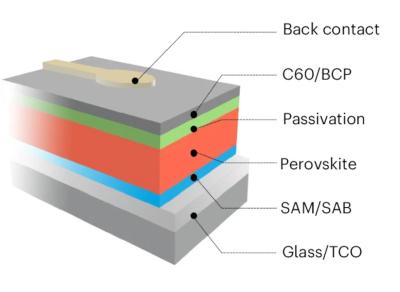![]() EPFL is a Switzerland-based technical university and research center. EPFL is focused on three missions: teaching, research and technology transfer.
EPFL is a Switzerland-based technical university and research center. EPFL is focused on three missions: teaching, research and technology transfer.
EPFL works together with an extensive network of partners including other universities and institutes of technology, secondary schools and colleges, industry and economy, political circles and the general public.
EPFL does extensive perovskite R&D work and is responsible for many publications and advancements in the field.
Route Cantonale
1015 Lausanne
Switzerland
Novel mixed-polymer-C60 strategy enables inverted perovskite solar cell with 25.6% efficiency
An international team, including researchers from EPFL, CNR SCITEC, Fujian Normal University, Southern University of Science and Technology (SUSTech) and others, has used an n-type polymeric additive to stabilize C60 molecules for use in inverted perovskite solar cells. The researchers reportedly designed a solar cell with the highest efficiency value ever recorded for perovskite devices based on solution processed C60 electron transport layers.
The team explained that C60 is currently the best-performing type of ETL for perovskite solar cells, although it suffers from “significant” aggregation in solution, which makes a high-cost and complex thermal evaporation method necessary for its development. To solve this issue, it utilized an n-type polymeric additive to stabilize C60 molecules for solution processing. “We introduced an n-type polymeric additive, TPDI-BTI, constructed from the strongly electron-deficient dithienylpyrazinediimide (TPDI) and the imide-functionalized bithiophene (BTI) co-unit and applied it into the C60 ETLs,” the researchers explained. “By controlling the TPDI-BTI addition, we can systematically regulate the ETLs, including film formability and morphological stability, energy levels and electron transport dynamics, intermolecular interacting behaviors and interfacial contacts, and finally, the photovoltaic performance and long-term stability of the cells.”
New type of hole-selective molecular contact enables inverted perovskite solar cell with >26% efficiency
Researchers from China's Xi’an Jiaotong University, Huazhong University of Science and Technology, Fudan University, ULVAC-PHI Instruments, National University of Singapore (NUS), Sweden's Uppsala University and EPFL have developed a self-assembled bilayer (SAB) that can be used as a hole contact material that grants improved adhesive contact with the perovskite film.
A schematic illustration of the inverted PSCs. Image from: Nature Energy
The team went on to fabricate an inverted perovskite solar cell that utilizes the self-assembled bilayer (SAB) as a hole-selective molecular contact. The cell was made with a substrate made of glass and transparent conductive oxides (TCOs), the proposed bilayer, the perovskite absorber, an ETL based on buckminsterfullerene (C60), a bathocuproine (BCP) buffer layer, and a silver (Ag) metal contact.
Researchers fabricate bifacial perovskite/silicon heterojunction tandem solar cells based on FAPbI3-based perovskite via hybrid evaporation-spin coating
Researchers from EPFL and CSEM recently fabricated efficient (>20 %) and stable (T80 ∼ 720 h) planar FAPbI3-based perovskite (1.54 eV) solar cells via a hybrid evaporation-spin coating process.
FAPbI3-based perovskite films were fabricated via a hybrid two-step evaporation-spin coating method in an inverted (p-i-n) configuration, and the effects of optimized parameters on the film growth and devices’ performances were investigated. Transferring these films into tandem devices atop single-side textured silicon heterojunction bottom cells, the team obtained an efficiency of >24 % under AM1.5 G illumination for monofacial devices with an active area of 1.21 cm2. Furthermore, the bifacial devices generated >27 mW cm−2 power output with 15 % rear illumination fraction.
Wide-bandgap perovskite films with improved crystal orientation enable all-perovskite tandem solar cells with >29% efficiency
Monolithic all-perovskite tandem solar cells present a promising approach for exceeding the efficiency limit of single-junction solar cells. However, the substantial open-circuit voltage loss in the wide-bandgap perovskite subcell hinders further improvements in power-conversion efficiency. Now, researchers from China's Nanjing University, Renshine Solar (Suzhou) and Ecole Polytechnique Fédérale de Lausanne (EPFL) have developed wide-bandgap perovskite films with improved crystal orientation that suppress non-radiative recombination.
The team showed that using two-dimensional perovskite as an intermediate phase on the film surface promotes heterogeneous nucleation along the three-dimensional perovskite facets during crystallization. Preferred orientations can be realized by augmenting the quantity of two-dimensional phases through surface composition engineering, without the need for excessive two-dimensional ligands that otherwise impede carrier transport.
Researchers tweak perovskite precursor solutions to produce useful cations that improve perovskite solar modules
Researchers from Ecole Polytechnique Fédérale de Lausanne (EPFL), North China Electric Power University, Westlake University, Lomonosov Moscow State University and others have described the addition of N,N-dimethylmethyleneiminium chloride ([Dmei]Cl) into perovskite precursor solutions to produce two cations in situ—namely 3-methyl-2,3,4,5-tetrahydro-1,3,5-triazin-1-ium ([MTTZ]+) and dimethylammonium ([DMA]+) cations - that enhanced the photovoltaic
performance and stability of perovskite solar modules.
A schematic of the roles of [MTTZ]+ and [DMA]+ in the 3D perovskite matrix. Image from: Science
The team explained that the in situ formation of [MTTZ]+ cation increased the formation energy of iodine vacancies and enhanced the migration energy barrier of iodide and cesium ions, which suppressed nonradiative recombination, thermal decomposition, and phase segregation processes.
Pagination
- Page 1
- Next page






